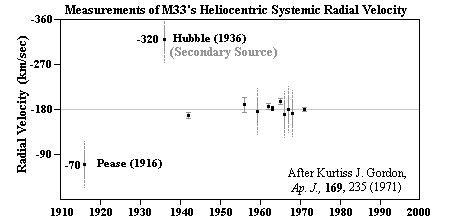Systemic Radial Velocity Measurements of Messier 33
Shade Tree PhysicsInstalled 12 Oct 2003. Latest update 14 Dec 2015.
Additions or changes are in bold.


|
The graph above shows a history of radial velocity measurements of Messier 33. It is based on Table 6 in Kurtiss J. Gordon's 1971(1)paper. The radial velocities that Gordon summarizes are listed below.
Author Speed (km/sec) Pease (1916) ................................................... -70 Hubble (1936)* ..............................................-320 Mayall and Aller (1942) ..................................-167 ± 5 p.e. Humason, Mayall, and Sandage (1956)........... -189± 15 est. Volders (1959) ...............................................-175 ± 2 Dieter (1962) ................................................. -186 ± 5 Burke et al. (1963) .........................................-179 ± 1 (minor axis) -184 (major axis) Brandt (1965) ................................................ -195 ± 7 p.e. Meng and Kraus (1966) ..................................-169 Davies (1967) ................................................ -179 Carranza et al. (1968) .....................................-172.5 Gordon (1971) ................................................-180 ±2.5 * Hubble(2) does not give any details as to the whom where, when and how for his reported -320 km/sec.M33 velocity. With this lack of information in mind, the author offers the following meddlesome speculation. (This will come back to bite!) The Earth's orbital velocity around the Sun is approximately 20 km/sec. Perhaps the photographs used in the velocity measurements were made in a timeframe when the Earth was receding from M33, i.e., during the month of December. A heliocentric velocity for M33 of -180 km/sec, less 20 km/sec for the Earth's motion away from M33, would lead to a relative velocity of -160 km/sec. If the mathematical factor used to convert spectral displacements to velocities was twice as big as it should be, (and nobody corrected for the Earth motion) then a figure of -320 km/sec would be expected. (Other options are just as bad.)
References(1) Gordon, Kurtiss, J., A 21-CENTIMETER Study of the Spiral Galaxy Messier 33. Ap.J., 169, 235-270 (1971). - NADS (2) Hubble, Edwin, The Realm of the Nebulae, Yale University Press, New Haven (1936), Page 141. |